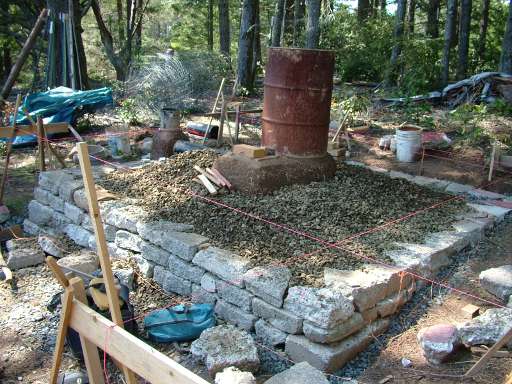Post by Donkey on Apr 5, 2012 18:20:44 GMT -8
The rain has stopped (for now) and I've had the opportunity to put the stove together and test it.
First, a picture of the tripwire and flow plate together (for context).

Intermediary image.. The heat riser isn't insulated yet, and I'm just getting the exhaust manifold and levels right. The exhaust pipe slopes down to the outside, in case there's condensation it'll run out.

I like to place the barrel and cob around everything while the fire is running; It gives instant feedback if I screw something up. I'll take the barrel off again later and clean it up. What's interesting here, and the reason for this post, is that usually at this point a stove won't be running it's best. The insides are wet, the works are cold, basically the worst conditions for a clean burn. There's always a but of smoke at this point, but NOT this time. With the p-channel plate in and the tripwire, this stove ran REALLY clean, even in these conditions. Basically what you're seeing in the image below is steam pouring out of a sloppy wet cob manifold.

And finally, from today, I've got all the bits closed up and have started work on the foundation again. Always test is my motto, so I did. Here's a pull-away shot that takes in the whole scene. Back in the background it the chimney stub (though no chimney on it yet). I couldn't get a picture of the steam, it was slightly windy and the stuff was too thin to photograph. If you squint at it, you can see a little haze in that direction.

It's totally surprising to me how well this thing works right now. I always say that when the stove is young and wet, it will run the worst that it ever will. It's my big test, if they work with no chimney and sloppy wet, they will typically always work.
Not only does this stove work, it runs CLEAN. I am now without any doubt as to the value of the P-channel and the tripwire.
First, a picture of the tripwire and flow plate together (for context).
Intermediary image.. The heat riser isn't insulated yet, and I'm just getting the exhaust manifold and levels right. The exhaust pipe slopes down to the outside, in case there's condensation it'll run out.
I like to place the barrel and cob around everything while the fire is running; It gives instant feedback if I screw something up. I'll take the barrel off again later and clean it up. What's interesting here, and the reason for this post, is that usually at this point a stove won't be running it's best. The insides are wet, the works are cold, basically the worst conditions for a clean burn. There's always a but of smoke at this point, but NOT this time. With the p-channel plate in and the tripwire, this stove ran REALLY clean, even in these conditions. Basically what you're seeing in the image below is steam pouring out of a sloppy wet cob manifold.
And finally, from today, I've got all the bits closed up and have started work on the foundation again. Always test is my motto, so I did. Here's a pull-away shot that takes in the whole scene. Back in the background it the chimney stub (though no chimney on it yet). I couldn't get a picture of the steam, it was slightly windy and the stuff was too thin to photograph. If you squint at it, you can see a little haze in that direction.
It's totally surprising to me how well this thing works right now. I always say that when the stove is young and wet, it will run the worst that it ever will. It's my big test, if they work with no chimney and sloppy wet, they will typically always work.
Not only does this stove work, it runs CLEAN. I am now without any doubt as to the value of the P-channel and the tripwire.


